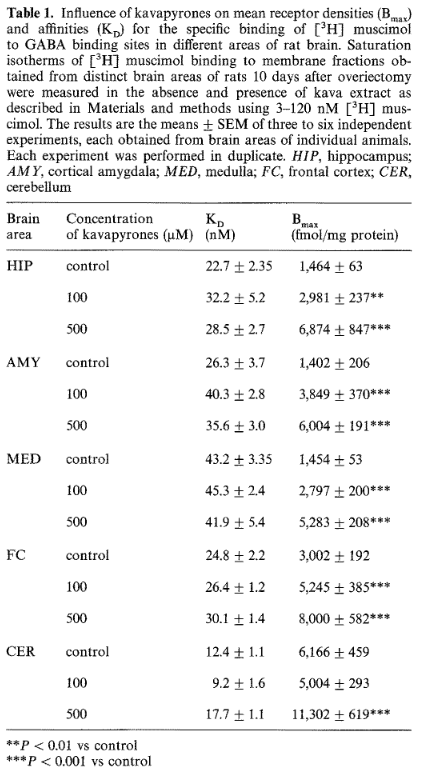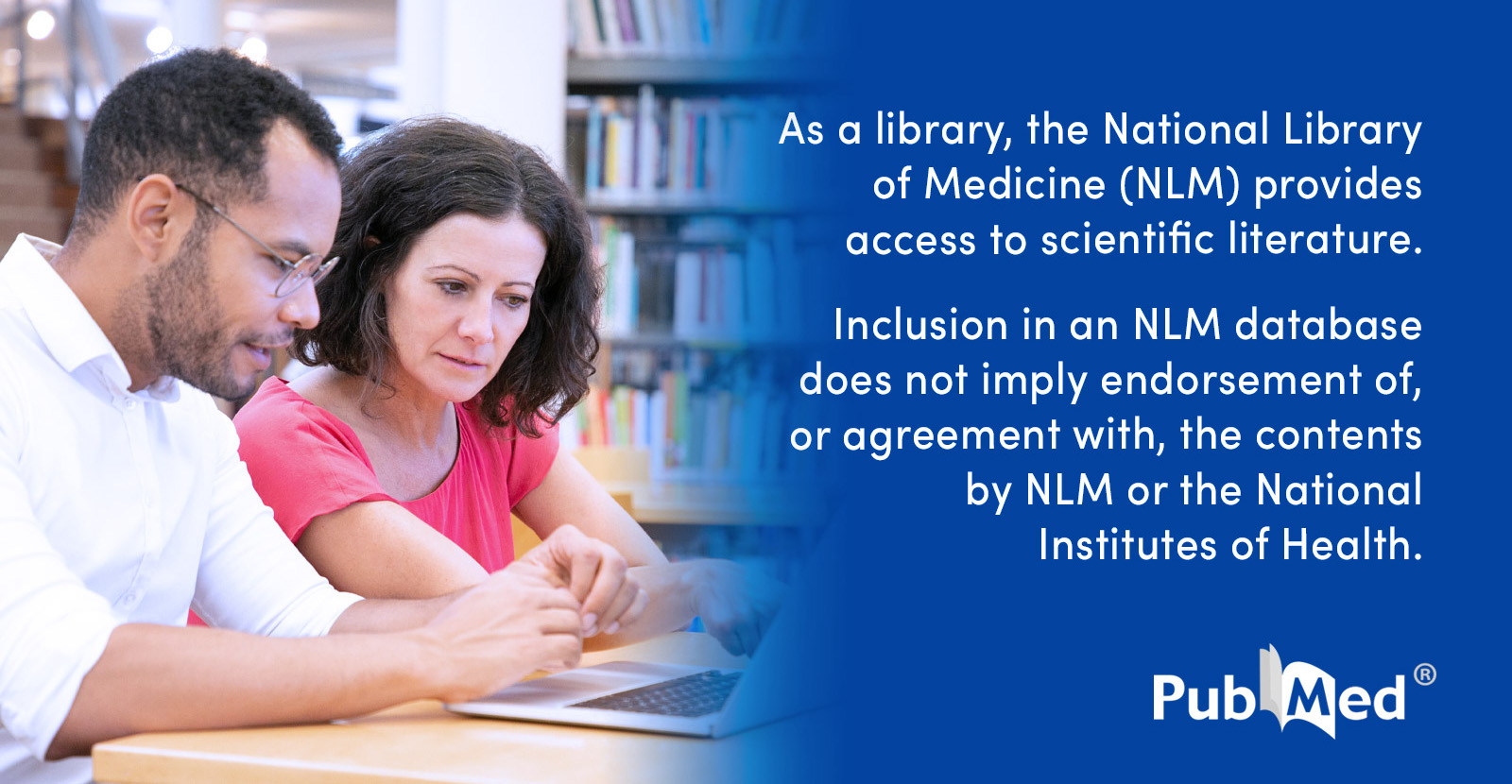Upregulation of GABA Receptors?
Today we’re going to look at one curious study regarding kava’s action at GABA in binding sites in different regions of rat brain. This study from 1994 comes prior to more timely studies which focus on kava and GABA, however it focuses on receptor density as well. We’re going to specifically look at a term known as B_max and how kavalactones affected this number.
What is B_max?
B_max is a parameter that is the measure of the binding of a drug and the number of receptors present in the sample. In short, it’s the maximum density of receptors [1]. This value tells us the physical number of binding sites, and in this case we’ll be seeing how kava may show an ability to increase this number.
What is “downregulation”?
Something you may have heard, especially if you’ve read any literature relating to drug addiction, is a term called “downregulation”. One function of drug tolerance is the desensitisation of receptors after repeated exposure to drugs which bind to them. A mechanism of this has been found to be the reduction in the number of binding sites that drugs can physically bind to [2].
What is “upregulation”?
Just as it looks, upregulation is the opposite action of downregulation. Upregulation refers to the increase in the number of receptor sites on a cell surface by which the orthosteric ligand (natural binding chemical) can attach [3].
So what was found in this kava study related to GABA-A receptor density?
Researchers applied two different concentrations of kavalactone extracts (full spectrum) at the dosage levels of 100um and 500um to see how these dosages affected different brain areas. It was seen that kavalactones influenced the receptor site densities in a dose dependent manner. In the following table you can see the numbers on the right under B_Max increase steadily. This number represents the quantity of receptors in the sample. Concentrations of GABA receptors in the cortical amygdala were seen to rise over 300% with various increases seen in all brain areas tested [4].

What does this mean to the average kava drinker?
Well, since this is one of the only studies referring to this phenomena, we can’t exactly say for sure. The dosages in this study, also, are much higher than what we can achieve when casually drinking kava. With this in mind and concerning the numbers in the above table, it seems that even lower dosages would cause this increase in receptor density to some degree. This finding could lend evidence to the physiological effect that kava can provide over time as kavalactones build up in the body. An increase in the number of GABA receptor sites will allow endogenous (naturally occurring) GABA to exert a larger inhibitory effect overall. Studies have remarked that this could be a main mechanism of action for kava [5], and this could possibly speak towards kava’s anxiolytic ability beyond that of its initial actions.
Summary:
Full-spectrum kava extracts were shown in rat brain to increase GABA binding sites relative to the dose that was given. This is directly opposite of what we see in addiction studies of receptors. Normally you see, with repeated administration of the chemical in question, a downregulation of receptor sites due to overactivation. When downregulation of receptors occurs, we see tolerance and withdrawal once the chemical in question is stopped. With kavalactones we see the opposite. In all areas of the brain studied a marked increase in GABA receptor density was observed. This may speak to kava’s long term ability to quell anxiety, and might possibly even lend a little evidence towards increasing effects over time.
[1] Dong, Chengyan, Zhaofei Liu, and Fan Wang. 2015. “Radioligand Saturation Binding for Quantitative Analysis of Ligand-Receptor Interactions.” Biophysics Reports 1: 148–55. https://doi.org/10.1007/s41048-016-0016-5
[2] Miller, L. G., S. Woolverton, D. J. Greenblatt, F. Lopez, R. B. Roy, and R. I. Shader. 1989. “Chronic Benzodiazepine Administration. IV. Rapid Development of Tolerance and Receptor Downregulation Associated with Alprazolam Administration.” Biochemical Pharmacology 38 (21): 3773–77. https://doi.org/10.1016/0006-2952(89)90584-4
[3] Edited by Dr. Esam El-Fakahany and Becky Merkey, & MEd. (n.d.). 16. Receptor Regulation. Principles of Pharmacology Study Guide. https://open.lib.umn.edu/pharmacology/chapter/receptor-regulation/
[4] Jussofie, A., A. Schmiz, and C. Hiemke. 1994. “Kavapyrone Enriched Extract from Piper Methysticum as Modulator of the GABA Binding Site in Different Regions of Rat Brain.” Psychopharmacology 116 (4): 469–74. https://doi.org/10.1007/BF02247480
[5] The Mechanism and Rationale for the Avoidance of Taking Benzodiazepines Along with Kava (Piper methysticum) and/or Valerian (Valeriana officinalis) Supplements. EBM Consult. https://www.ebmconsult.com/articles...valerian-valeriana-officinalis-cns-depression
| Edit: 09/08/2021 |
|---|
| This information has been refuted. I asked one of the world leading kava researchers, Dr. Matthias Schmidt about this specific question, and this was his response: "The paper was published in 1994. This was a time when GABA receptor interactions were “en vogue”, and any herbal effect was explained by this mechanism. When this generally did not work out, the GABA hype was slowly forgotten. I am afraid it is no different with kava, especially as receptor interactions are usually demonstrated in vitro, and then you cannot really draw conclusions on what’s happening in the human organism. Ultimately we do not really know the exact mechanism of action, but that’s also true for many chemically defined drugs. In contrast, the effect can be demonstrated and reproduced in animal experiments, so we know exactly that it works, we just do not known what biochemistry is in the play." |
Today we’re going to look at one curious study regarding kava’s action at GABA in binding sites in different regions of rat brain. This study from 1994 comes prior to more timely studies which focus on kava and GABA, however it focuses on receptor density as well. We’re going to specifically look at a term known as B_max and how kavalactones affected this number.
What is B_max?
B_max is a parameter that is the measure of the binding of a drug and the number of receptors present in the sample. In short, it’s the maximum density of receptors [1]. This value tells us the physical number of binding sites, and in this case we’ll be seeing how kava may show an ability to increase this number.
What is “downregulation”?
Something you may have heard, especially if you’ve read any literature relating to drug addiction, is a term called “downregulation”. One function of drug tolerance is the desensitisation of receptors after repeated exposure to drugs which bind to them. A mechanism of this has been found to be the reduction in the number of binding sites that drugs can physically bind to [2].
What is “upregulation”?
Just as it looks, upregulation is the opposite action of downregulation. Upregulation refers to the increase in the number of receptor sites on a cell surface by which the orthosteric ligand (natural binding chemical) can attach [3].
So what was found in this kava study related to GABA-A receptor density?
Researchers applied two different concentrations of kavalactone extracts (full spectrum) at the dosage levels of 100um and 500um to see how these dosages affected different brain areas. It was seen that kavalactones influenced the receptor site densities in a dose dependent manner. In the following table you can see the numbers on the right under B_Max increase steadily. This number represents the quantity of receptors in the sample. Concentrations of GABA receptors in the cortical amygdala were seen to rise over 300% with various increases seen in all brain areas tested [4].
What does this mean to the average kava drinker?
Well, since this is one of the only studies referring to this phenomena, we can’t exactly say for sure. The dosages in this study, also, are much higher than what we can achieve when casually drinking kava. With this in mind and concerning the numbers in the above table, it seems that even lower dosages would cause this increase in receptor density to some degree. This finding could lend evidence to the physiological effect that kava can provide over time as kavalactones build up in the body. An increase in the number of GABA receptor sites will allow endogenous (naturally occurring) GABA to exert a larger inhibitory effect overall. Studies have remarked that this could be a main mechanism of action for kava [5], and this could possibly speak towards kava’s anxiolytic ability beyond that of its initial actions.
Summary:
Full-spectrum kava extracts were shown in rat brain to increase GABA binding sites relative to the dose that was given. This is directly opposite of what we see in addiction studies of receptors. Normally you see, with repeated administration of the chemical in question, a downregulation of receptor sites due to overactivation. When downregulation of receptors occurs, we see tolerance and withdrawal once the chemical in question is stopped. With kavalactones we see the opposite. In all areas of the brain studied a marked increase in GABA receptor density was observed. This may speak to kava’s long term ability to quell anxiety, and might possibly even lend a little evidence towards increasing effects over time.
[1] Dong, Chengyan, Zhaofei Liu, and Fan Wang. 2015. “Radioligand Saturation Binding for Quantitative Analysis of Ligand-Receptor Interactions.” Biophysics Reports 1: 148–55. https://doi.org/10.1007/s41048-016-0016-5
[2] Miller, L. G., S. Woolverton, D. J. Greenblatt, F. Lopez, R. B. Roy, and R. I. Shader. 1989. “Chronic Benzodiazepine Administration. IV. Rapid Development of Tolerance and Receptor Downregulation Associated with Alprazolam Administration.” Biochemical Pharmacology 38 (21): 3773–77. https://doi.org/10.1016/0006-2952(89)90584-4
[3] Edited by Dr. Esam El-Fakahany and Becky Merkey, & MEd. (n.d.). 16. Receptor Regulation. Principles of Pharmacology Study Guide. https://open.lib.umn.edu/pharmacology/chapter/receptor-regulation/
[4] Jussofie, A., A. Schmiz, and C. Hiemke. 1994. “Kavapyrone Enriched Extract from Piper Methysticum as Modulator of the GABA Binding Site in Different Regions of Rat Brain.” Psychopharmacology 116 (4): 469–74. https://doi.org/10.1007/BF02247480
[5] The Mechanism and Rationale for the Avoidance of Taking Benzodiazepines Along with Kava (Piper methysticum) and/or Valerian (Valeriana officinalis) Supplements. EBM Consult. https://www.ebmconsult.com/articles...valerian-valeriana-officinalis-cns-depression
Last edited:

